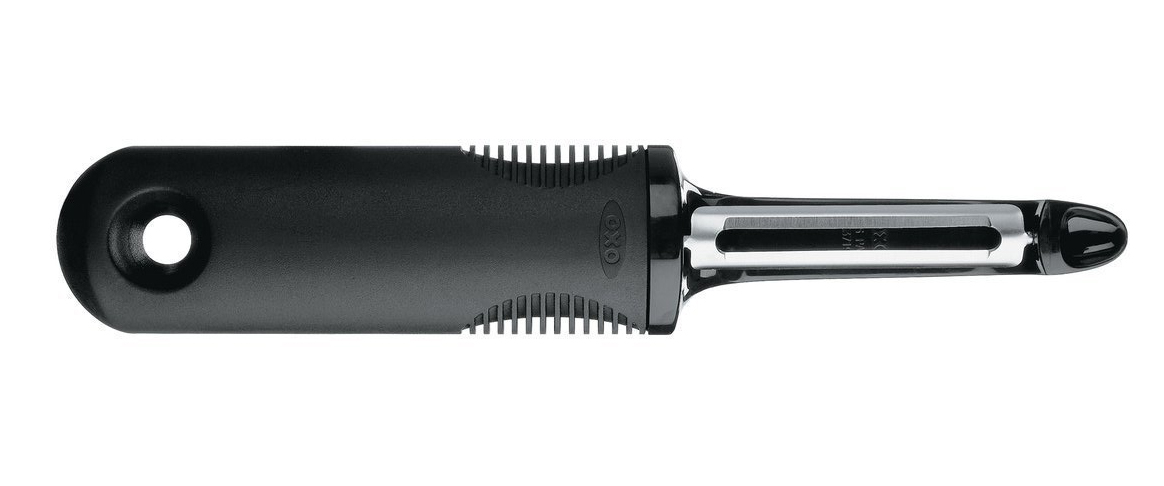Module 3 - Section 3
What is User-Centred Design?
This is my vegetable peeler.
Maybe somewhere in your kitchen drawer you have a peeler, bottle
opener or other kitchen tool made by Good Grips. I cook a lot, and
this peeler simply works very well, and indeed is one of the
world's most popular utensils of its type. The millions who use it
every day are probably unaware that this is a practical design
outcome of one of the most remarkable cases of user centred design
ever undertaken. Indeed, this user research changed the face of
design, changed its concerns and focus, and in so doing created
one of the few real heroes of design user research.

Watch this short film about Patricia Moore:
As the film explains "For a period of three years (1979-1982), in
an exceptional and daring experiment, industrial designer Patricia
Moore traveled throughout the United States and Canada disguised
as a woman of more than eighty years of age. With her body altered
to simulate the normal sensory changes associated with aging, she
was able to respond to people, products, and environments as an
elder." The insights gained opened up the design profession to
addressing the needs of older users. The OXO Good Grips kitchen
tools was one of a number of product ranges she later worked on,
applying her insights and the empathy she had gained. In addition
to specific products, she was instrumental in creating a whole new
philosophy of design - universal design. Also referred to as
'inclusive design', it is design that works well for everyone
regardless of age or ability.
Understanding users is vital to the process of design. It is
fundamental, and is no less creative than any other design
activity - indeed as culture, society and technologies become more
complex, so we need evermore creative approaches to understanding
the needs, desires, feelings, fears and loves of people.
The value of UCD for technology design, competitiveness and better
public services
We met Don Norman back at the start of this module. He is a
pioneer of user centred design - indeed he even coined the term UX
design. His work for Apple Computers, leading their UX team,
ensured that they have taken an enviable lead in producing highly
useable and desirable products.
Nick Bray is Director of UX at Visual Logic, a US based company.
Read his paper why human-centered design is an expectation, which
should take you about 10 minutes. As you do so, note your key
observations. In it he argues why putting people at the centre of
innovation is vital. It is written from a fairly corporate
perspective, so will need some translation to your own domain!
https://uxdesign.cc/why-human-centered-design-is-an-expectation-a02df9638fa7#.lfjdgi65j
As Nick says right at the end of the piece: “Human-centred design
should be an integral part of your planning, both in the
day-to-day and for future visioning. The process is built around
finding real motivations and behaviours, and executing on
iterative and healthy growth. It reduces the dependency on luck,
creates confident decision makers, and strengthens the
relationship with your customers. Human-centred design
methodologies are not something you can tack onto your process. It
is your process.”
So, is this just of interest to corporates and start-ups? Far from
it. User centred design is also on the agenda of government and we
can find good evidence of it at policy making levels as these two
readings show:
https://openpolicy.blog.gov.uk/2015/06/12/what-do-civil-servants-need-to-learn-about-user-centred-design/
https://openpolicy.blog.gov.uk/2015/03/20/design-in-policy-making/

Activity 6
Blog
Louise Downe is Director of Design for the UK Government. Over 300 designers work in government. They are not working on designing letter headings, but on helping to design and deliver what accounts for 80% of total government expenditure - delivering services to individuals and businesses. As you watch this 30 minute video of a talk by Louise, write down your observations and thoughts and - again - pull out the implications for your own work.
Co-Design
User centred design involves seeing the world through our users’ eyes,
to experience what they experience, and to ensure that what we design
meets all the needs of our users. In the next part of this module we
will look in some detail at the design methods that help us to do
this. But in the meantime we are going to look at how we can involve
our users directly in the design process - by using co-design.
Begin by reading a clear and concise introduction to co-design from
John Chisholm, Researcher in Design Management at Lancaster
University:
http://designforeurope.eu/what-co-design
Now we have a more detailed activity for you.

Activity 7.1
Blog
Wina Smeenk was formerly a strategist and designer at various international companies. Since 2016 she has been based at the Industrial Design faculty of Eindhoven University of Technology researching Empathic Co- Design. By obtaining experiences and feelings from people with dementia, she successfully helped creating a dementia simulator. She did this by making use of different sessions, which all made use of empathic co- design and co-creation. Watch this six minute talk by her, and as you do note down the methods she uses to place people at the heart of the design process. How has she sought to make the design process engaging? How could you apply or adapt these methods to your own practice?

Activity 7.2
Blog
The next part of this activity will take a little longer.
Developing the Young Workforce is an initiative by Dundee City
Council that brought together people involved in the delivery
and use of employment services for young people to discover how
these services are currently experienced by the under 25s in the
city and explore how services can develop in the future. It was
run by innovation agency Open Change in partnership with the
Council. The approach taken and methods used placed young people
right at the heart of focused conversations and discussions that
aimed to capture their experiences, insights and aspirations.
The link here will take you to the Council website, from which
you can watch a short film and - most importantly - read the
project report. What are your thought on the methods used here?
How transferable are they? What lessons can be learned for your
own field?
http://www.dundeecity.gov.uk/youngworkforce You should post
your response to this activity(on your blog.